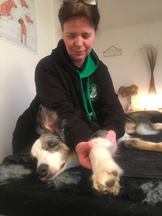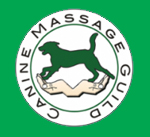Benefits of Clinical Canine Massage
Clinical Canine Massage aims to resolve or support issues in just 1-3 sessions, often delivering outstanding results that surprise both owners and other professionals alike. Quite simply, there is nothing quite like it!
It may be that x-rays taken have been inconclusive and your dog has been prescribed anti-inflammatory/pain relief and rest. It may be that your dog is on long-term medication or has not responded as well as you had hoped to other forms of bodywork, exercise therapy or pain management and you don’t know where else to turn. That’s where Clinical Canine Massage can help. Canine Massage Guild therapists are trained in 4 Disciplines of Massage as well as The Lenton Method® to help turn your dog’s life around :
- Reduced pain / discomfort = a happier dog 😊
- Relieved stiffness / soreness
- Restore function
- Rehabilitate muscular injury
- Improved movement ability, moving more freely
- Improves elasticity and flexibility of muscles and promotes full or improved range of motion
- Supports orthopaedic conditions like Arthritis, Hip Dysplasia, Elbow Dysplasia, Luxating Patella and Spondylosis, making dog better able to cope with long-term condition
- Resolves or improves lameness
- Improve senior dog’s mobility
- Provide chronic pain management for arthritis and orthopaedic conditions
- Improves circulation and coat, enhancing delivery of nutrients and oxygen and removal of waste products and toxins of metabolism
- Reduces and remodels inhibiting scar tissue
- Relief from chronic muscular issues often overlooked by traditional veterinary care
- Releases trigger points and areas of spasm
- Improves Agility / Obedience / Flyball sports performance significantly
- Breaks down knots and adhesions which inhibit movement
- Resolves gait irregularities
- Emotionally and psychologically ‘lifts’ the dog, improving mood
- Non-invasive, natural, drug-free pain relief and treatment
- Decreases fatigue and malaise
- Alleviates age related disorders
- Faster recovery from injury and operations ie, Cruciate Ligament surgery, etc
- More accepting of being handled – helps with vets, groomers, etc
- More able to get in/out of car, up stairs
- More enthusiastic for walks and enjoying them better, able to walk further
- More interactive and sociable with other dogs
- Helps the nervous or anxious dog and improves focus
- Calms the boisterous dog by inducing relaxation
- Improves coat condition via desquamation and sebum spread
- Able to live a full life again, have their ‘zest’ for life back
Some causes of soft tissue injury symptoms
Strains – a tear to the muscle and the most common muscular injury; can occur at any age
Trigger Points – hyperirritable bands in the tissue that cause localised and referred pain
Myofascial Pain – a chronic pain disorder caused by connective tissue restrictions which surround nerves
Overcompensation – weight shifting from areas of injury or arthritis which create new areas of painful tension
Protective Muscle Splinting – commonly associated with the muscle having to work too hard due to orthopaedic issues like hip or elbow dysplasia



